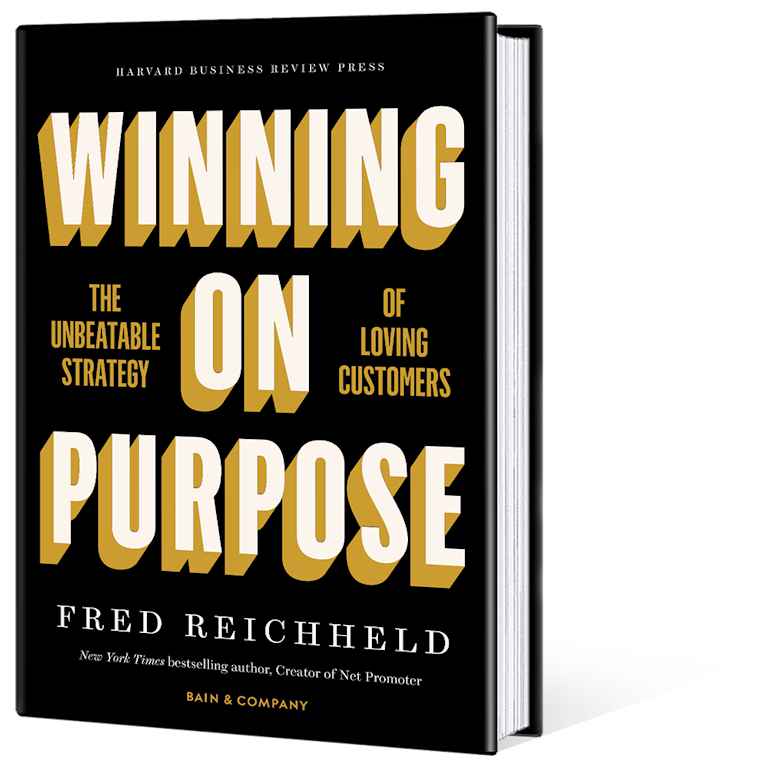
This article originally appeared on LinkedIn.
Inflation is worse than you think. We all know that gas is expensive—averaging $3.41 a gallon in the US as of mid-November—and that food prices and rents are climbing. Fast Company calculates that a typical Thanksgiving dinner will cost you 14% more this year.
But October’s overall 6.2% surge in consumer prices, while the biggest in more than 30 years, tells only part of the story. It’s missing shadow inflation, also called “shrinkflation,” the practice of giving you less for the same price. As the New York Times’s The Upshot recently explained in a column titled “There Is Shadow Inflation Taking Place All Around Us,” this form of inflation is simply not captured in any of the government data.

Winning on Purpose: The Unbeatable Strategy of Loving Customers
This new book by Fred Reichheld, Darci Darnell, and Maureen Burns demonstrates that great leaders embrace a higher purpose to win, and Net Promoter® shines as their guiding star.
In our own lives, we’ve encountered proof that inflation is much higher than 6%, and you likely have too. Sit down at a restaurant and order using the QR code so the harried waiter can cover two times the tables. Buying a new car? Chip shortages and supply chain bottlenecks mean you had better be flexible on color. Even Amazon, a company with an avowed desire to always put the customer first and a pretty strong track record of doing so, recently announced that Prime subscriptions would no longer include free Whole Foods delivery. Prime members still pay $119 a year, but now they also have to pay $9.95 any time they want something from Whole Foods at their doorstep.
Businesses face large challenges right now, from labor shortages to supply chain disruptions, but giving customers less for their money is the opposite of customer love. Leaders can make the best of a tough situation by doubling down on innovation and transparency.
One of the chapters in our upcoming book, Winning on Purpose (publishing December 7!), is called “Be Remarkable: Not Merely Satisfactory.” Examples include former Discover CEO David Nelms’s customer-centric decision to risk $200 million in late-fee revenues by sending customers an email alert the day before the fee would be levied. Or Costco’s decision to sell Calvin Klein jeans at the company’s standard 14% markup amid ample evidence that there was more money on the table just waiting to be scooped up.
NPS exemplars regularly achieve the remarkable, but it takes effort. They work in systematic and ever-changing ways. Costco’s cofounder and former CEO Jim Sinegal says that, in his view, simply providing the best everyday low price in Costco warehouse stores wasn’t enough for the company to thrive in the long term. The human brain is a bit perverse in this regard: As soon as it discerns a pattern, it starts to get bored with that pattern. We start out justifiably excited about something new—let’s say, some very good thing—but over time we lose interest even though that thing remains very good.
We need some surprise to wow us and inspire us to talk about that experience with friends and colleagues. That’s why Costco strives to turn every visit into a treasure hunt, with fresh inventory and incredible bargains. The company rewards your need to discover. It amps up your adrenaline levels by (truthfully) suggesting that you had better grab this great deal now because it’s likely to be sold out well before your next visit. And again, that’s pretty much true, which is why you don’t end up feeling manipulated. Indeed, Costco makes it easy to return any item, removing the risk of buyer’s remorse. Costco can’t be immune to the inflationary pressure bearing down on the economy, but a history of working hard at being remarkable has it adapting from a position of strength.
Innovators are finding new ways to be remarkable that engage customers and give them a sense of fun. Apps like Strava and Duolingo are employing gamification to make exercise and language study competitive, challenging, and more enjoyable. Dunkin’s scratch games and sweepstakes feature language and concepts—like streaks—that Snapchat has made familiar to young consumers, helping to push up repeat visits.
Innovations like these are important, but so is transparency. If you have to raise prices, be clear about why. Take the time to walk customers through the math. If labor costs have doubled, let them know that. You may find customers appreciate that you are taking care of your employees. And for those who just can’t afford the higher price, tiered pricing can help. For a service provider like a gym or a cleaning service, that might mean adding a lower-priced plan for people who use the service less frequently.
No one wants to pay more, but inflation doesn’t have to make your company any less remarkable.


